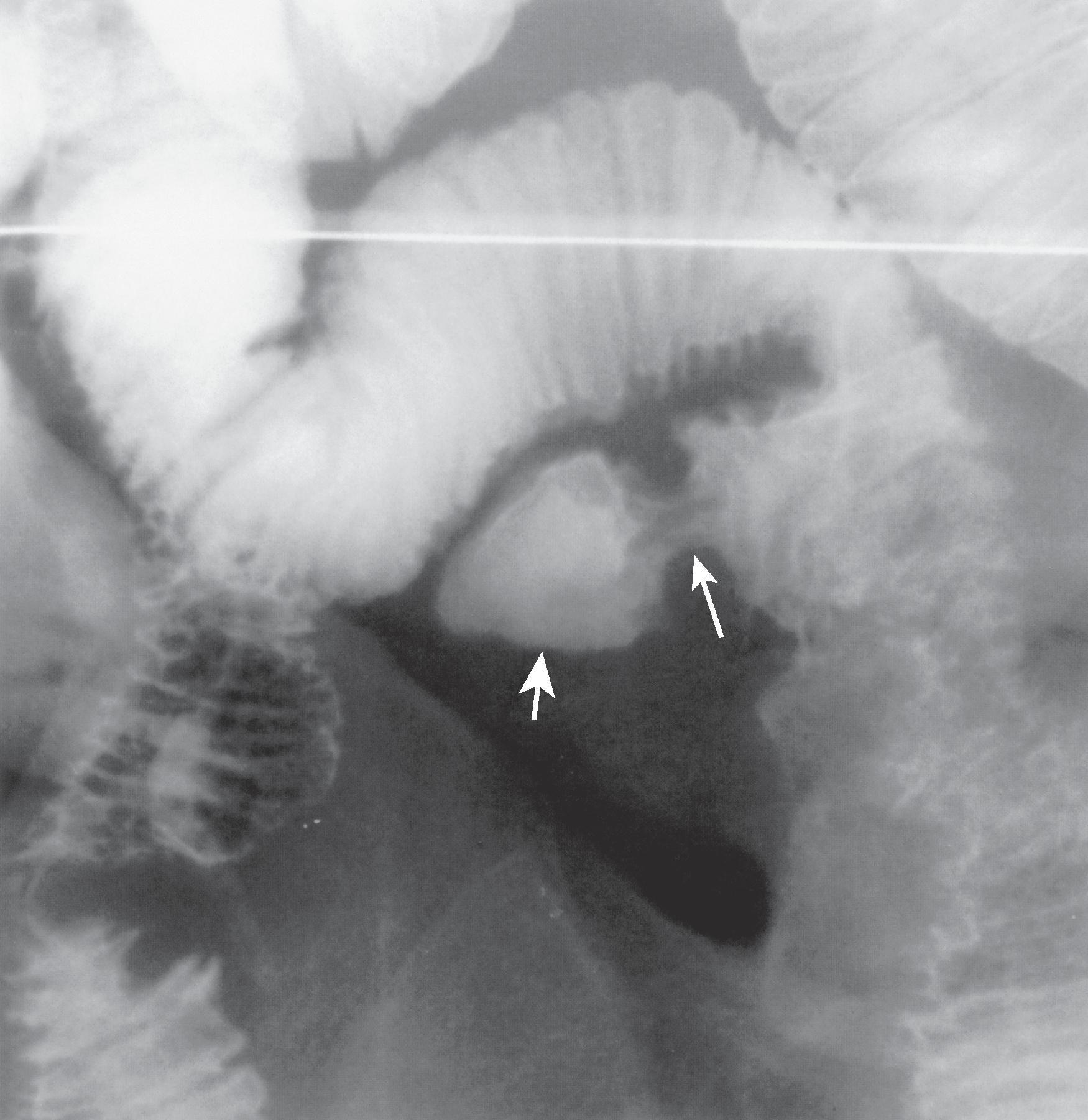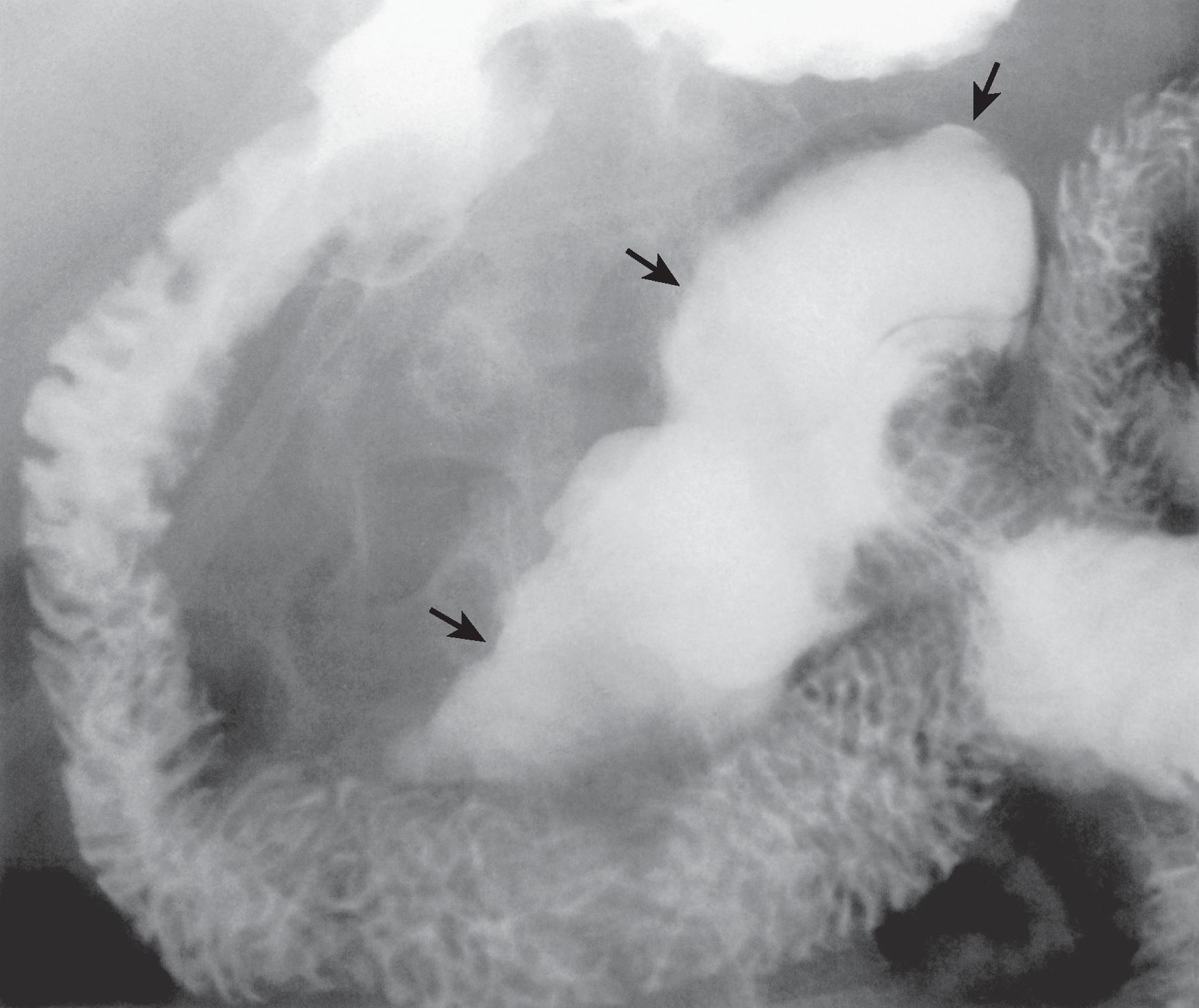Physical Address
304 North Cardinal St.
Dorchester Center, MA 02124
During embryologic development, the yolk sac is connected to the midgut by the omphalomesenteric duct, which is later obliterated during the seventh to eighth weeks of embryogenesis. Persistence of the entire omphalomesenteric duct results in an enteroumbilical fistula; persistence of part of the duct results in an omphalomesenteric cyst; persistence of the duct as a fibrous cord can result in volvulus or compressive obstruction; and persistence of the duct at its attachment to the ileum results in a Meckel’s diverticulum, the most common congenital anomaly in the gastrointestinal (GI) tract.
The prevalence of Meckel’s diverticulum at autopsy is 1% to 4%, but affected individuals rarely develop symptoms. This structure arises from the antimesenteric border of the ileum within 100 cm of the ileocecal valve and may be connected to the umbilicus or other intestinal loops by congenital bands or adhesions. The diverticulum is usually 2 to 15 cm in length and about 2 cm in width. Meckel’s diverticulum contains all layers of the small bowel wall and, not infrequently, heterotopic gastric or pancreatic tissue.
Infants with Meckel’s diverticulum may present with GI bleeding secondary to ulceration resulting from secretion of acid by ectopic gastric mucosa in the diverticulum. In contrast, adults may present with GI bleeding, perforation, or intestinal obstruction. , Diverticular perforation and subsequent diverticulitis may be caused by an enterolith, foreign body impaction, or perforated ulcer. Small bowel obstruction may result from small bowel intussusception or small bowel volvulus around a persistent fibrous band. The diverticulum may also become incarcerated in an inguinal, femoral, or umbilical hernia (Littré hernia). Rarely, cases of a carcinoid tumor, adenocarcinoma, or benign or malignant mesenchymal tumor arising in Meckel’s diverticulum have been reported.
Ectopic gastric mucosa may be detected in the diverticulum on technetium pertechnetate scintigraphy in more than 85% of patients with Meckel’s diverticulum who present with GI bleeding. Nevertheless, most adults with Meckel’s diverticulum are asymptomatic or develop symptoms related to obstruction. All imaging modalities (except enteroclysis) have a poor sensitivity for detecting Meckel’s diverticulum. Abdominal radiographs may occasionally reveal radiopaque enteroliths in the diverticulum. Meckel’s diverticulum is rarely diagnosed on small bowel follow-throughs, except for studies in which barium-filled ileal loops are separated by excessive mesenteric fat related to obesity or Crohn’s disease. When the diverticulum is identified on barium studies, it typically appears as a blind-ending tubular or cystic sac ( Fig. 35.1 ) that communicates with the antimesenteric border of the distal ileum. The diverticulum may contain focal ulceration or a polypoid mound of ectopic gastric mucosa or tumor. An inverted Meckel’s diverticulum appears as a smooth, elongated or club-shaped intraluminal mass that may act as the lead point for a small bowel intussusception. Computed tomography (CT) or ultrasound may show a cystic or tubular structure attached to the bowel in the right lower quadrant.

Small bowel duplications are congenital anomalies characterized by complete or incomplete “doubling” of a variably long segment of bowel. Midgut duplication cysts usually have an intestinal lining containing a mucosa, submucosa, and inner circular muscle layer with its associated myenteric plexus. Some duplications also contain a full longitudinal muscle layer, but others contain no longitudinal muscle. Duplication cysts may also contain gastric mucosa, pancreatic tissue, thyroid stroma, ciliated bronchial epithelium, lung tissue, and cartilage.
Most midgut duplications involve the duodenum or distal ileum near the ileocecal valve. These are usually elongated lesions attached to the muscular layer of the adjacent small bowel. As secretions accumulate, the duplication may become a cystic mass protruding into the small bowel mesentery. Multiple duplications are found in 5% of patients. About 5% of duplication cysts communicate with the bowel lumen at their proximal or distal ends or at both ends.
Ectopic gastric mucosa within ileal duplication cysts may cause ulceration with subsequent GI bleeding or perforation. Obstruction may result from volvulus, intussusception, or compression of the adjacent bowel by the cyst. Rarely, duplication cysts are complicated by tumor.
Duplication cysts are characterized on barium studies by an extrinsic mass indenting and compressing the mesenteric border of the adjacent bowel. Barium may occasionally enter a communicating duplication cyst ( Fig. 35.2 ). CT or ultrasound may reveal a cystic mass embedded in the adjacent small bowel wall. , In patients with GI bleeding, 99m Tc-pertechnetate scans usually reveal heterotopic gastric mucosa within the cyst.

Become a Clinical Tree membership for Full access and enjoy Unlimited articles
If you are a member. Log in here